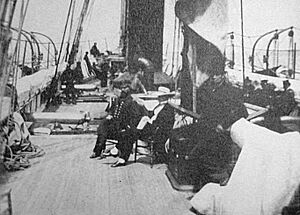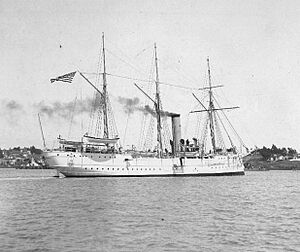United States Revenue Cutter Service facts for kids
The United States Revenue Cutter Service (USRCS) was like an early version of the United States Coast Guard. It started in 1790 when President George Washington signed a law to build 10 special boats. These boats were meant to collect taxes on goods coming into the country. They also stopped smuggling and made sure American goods could be sold in other countries. In 1915, President Woodrow Wilson signed a new law. This law created the United States Coast Guard. It combined the Revenue Cutter Service with another group called the United States Life-Saving Service. The Coast Guard became a part of the U.S. military.
Contents
History of the Revenue Cutters
Alexander Hamilton, the first Secretary of the Treasury, first suggested creating the Revenue Cutter Service. He wrote about it in a letter in October 1789. After Congress agreed, the service began with 10 boats. These boats were called cutters. A cutter was a small, fast sailing boat with one mast.
Before the Revenue Cutter Service, the Continental Navy had been shut down. So, until the United States Navy was formed in 1794, the Revenue Cutter Service was the only naval force the country had.
After the American Revolutionary War, the United States was having money problems. The new country relied on money from import taxes. During the war, smuggling was seen as a good thing. But now, it was taking away money the country badly needed. Hamilton knew the country would suffer if nothing was done. He thought a fleet of 10 cutters could collect taxes and stop smuggling.
The first cutters were planned to be about 36 to 40 feet long. Each boat would have two officers, six marines, and about 10 other crew members.
The First 10 Cutters
The North Carolina was bought in 1792 for the Revenue Marine Service. This was even though it wasn't one of the first 10 boats Hamilton asked for. Before the first 10 were approved, some other boats were used. These were used as early as 1781.
Here are the first 10 cutters that were built:
- USRC Vigilant (1791) was launched in March 1791 in New York. It patrolled the waters around New York. Patrick Dennis was its first captain. This first Vigilant was sold in November 1798.
- USRC Active (1791) was built by David Stodder in Baltimore, Maryland. It launched on April 9, 1791, and was based in Baltimore. The Active patrolled the Chesapeake Bay. Simon Gross was its first captain. This first Active was sold in 1800.
- USRC General Green (1791) launched in Philadelphia, Pennsylvania on July 7, 1791. It was built by David Price and stationed in the Delaware Bay. James Montegomery was its first captain. The first General Green was sold in December 1797.
- USRC Massachusetts (1791) was built in Cohasset, Massachusetts by Adna Bates. It launched on July 15, 1791. It was larger than planned, being 60 feet long. John Foster Williams was its first captain. The Massachusetts was sold on October 9, 1792.
- USRC Scammel (1791) launched on August 24, 1791, in Portsmouth, New Hampshire. It was 57 feet long. Hopley Yeaton was its first captain. It was sold on August 16, 1798.
- USRC Argus (1791) was built and launched in 1791 in New London, Connecticut. It stayed stationed there. Jonathan Maltbie was its first captain. The first Argus was sold in 1804. It was about 47 feet long.
- USRC Virginia (1791) was built and launched in 1791 in Hampton, Virginia. It was stationed in Norfolk, Virginia. Richard Taylor was its first captain. The first Virginia was sold in 1798. It was 40 feet long, matching the original plans.
- USRC Diligence (1791) was built in Washington, North Carolina. It launched there in June or July 1792. William Cook was its first captain. The first Diligence was sold in 1798.
- USRC South Carolina (1791) was built in Charleston, South Carolina and launched in 1792. It was based in Charleston and patrolled North Carolina waters. Robert Cochrane was its first captain. The first South Carolina was sold on June 5, 1798.
- USRC Eagle was built and launched in Savannah, Georgia in 1793. It patrolled Georgia waters. John Howell was its first captain. The first Eagle was sold on September 14, 1799.
Quasi-War with France
Disagreements over treaties led to an undeclared war between France and the United States. This conflict was fought at sea from 1798 to 1800. However, French privateers (private ships allowed to attack enemy ships) had been robbing American ships for years before. American merchant ships were also attacked by pirates.
Revenue cutters were sent to deal with the pirates. But soon, the French privateers and pirates were too much for the service alone. Congress created a permanent navy in 1794. The new United States Navy and the Revenue Cutter Service worked together. They protected American ships.
Revenue Cutters went to the Caribbean Sea in 1799. They protected American shipping from French warships. In 1799, about 12 French warships were captured by Revenue cutters. One captured ship, the 6-gun Bon Perre, was even used as a Revenue cutter. In 1800, two cutters, the Pickering and the Insurgente, were lost at sea. No one survived to explain what happened.
After the treaty with France was signed in 1801, many thought the Revenue Cutter Service should be smaller. Its larger cutters were too expensive to keep. Many big, older cutters were sold, and many junior officers lost their jobs.
War of 1812
When the War of 1812 began, the Navy had only a few small ships. None were as fast as the cutters. The cutters were small and could go into shallow water. They suffered many losses but showed they were strong fighters.
The cutter Jefferson captured the first British merchant ship in June 1812. In July, the cutter James Madison captured another British ship. In one battle, the cutter Surveyor fought bravely against a larger British frigate. When the Surveyor finally surrendered, the British captain returned the American captain's sword. This was a sign of respect for his bravery.
The cutter Commodore Barry was captured by British forces after a strong fight. In another event, the cutter Eagle ran aground during a battle. Its crew dragged the ship's guns onto a bluff. They kept fighting until late in the day. When they ran out of cannonballs, they supposedly fired back the British ones! The War of 1812 was the only time USRCS members were taken as prisoners of war by an enemy until World War II. This war proved the USRCS could stand its ground against even the strongest navies.
Mexican–American War
During the Mexican–American War, President James K. Polk ordered the cutters in the Gulf of Mexico to help the United States Army. By the end of the war, eight cutters had served with the Army. This was out of only 14 cutters in total.
These cutters could operate in shallow water. They were also useful for landing troops on beaches. The Revenue cutters helped block enemy ports. They carried men and supplies. They also supported both Army and Navy operations.
In October 1847, the service was low on money. The costs of operating in Mexico had used up many funds. The service had to stop building new ships. They also had to get rid of expensive old ones. The USRCS was reduced to only eight cutters. By 1849, six new cutters were ordered. But between the Chesapeake Bay and Florida, there were only two cutters. One more served in the Gulf of Mexico. Two new cutters would serve in the Atlantic, and four would go to the West Coast.
Civil War
Just before the American Civil War, the Revenue Cutter Service had only 24 cutters. These guarded both coasts of the United States. Twenty-three of these were wooden sailing ships. They ranged from 25 to 100 feet long. Most were sloops or schooners. One was a brig.
The service also had one modern (for that time) wooden paddle steamer. This was the USRC Harriet Lane, built in 1857-1858. The Harriet Lane was the best ship in the service. It was also the only cutter with a full crew. The rest of the fleet barely had enough officers and men.
Money cuts in the 1840s and 1850s meant no pay raises. This left the service short of men. During this time, the service began winter patrols in the North Atlantic. They protected sailors there. They also started enforcing immigration laws. This was especially true on the West Coast, where many Chinese workers were brought in on crowded ships.
At the start of the war, some officers and men left. They joined the Confederacy. They formed the core of the Confederate Revenue Marine. Six cutters were seized by Confederate forces in Southern ports. The Harriet Lane was temporarily given to the Union Navy. President Abraham Lincoln asked the Navy to transfer more ships to the Revenue Cutter Service. But there are no records showing if any were actually transferred.
During the rest of the war, Revenue cutters protected Northern shipping. They also helped the Navy blockade Southern ports. The cutter Harriet Lane fired the first shots of the Civil War from a ship. But in 1863, the Harriet Lane was captured in a battle. Nearly all its crew members were killed.
Spanish–American War
On April 21, 1898, the United States declared war against Spain. President William McKinley temporarily put the Revenue Cutter Service ships under the Secretary of the Navy. They were ordered to work with the Navy. They became part of the Navy's support forces.
The Revenue Cutter Service provided 13 cutters to help the Navy. Eight served in the North Atlantic. Four patrolled the West Coast. One served with Admiral George Dewey's squadron in Asia.
United States Coast Guard
The Revenue Cutter Service and the U.S. Life-Saving Service joined together. They formed the United States Coast Guard on January 28, 1915. The new law made the Coast Guard a permanent part of the United States military. It also allowed it to be transferred to the U.S. Navy whenever needed. It had been a custom to put the Revenue Cutter Service under Navy control during crises. But now, it was made official by the new law, which also changed its name.
Images for kids
-
Officers of the revenue cutter Perry in the Aleutian Islands, 1906.















